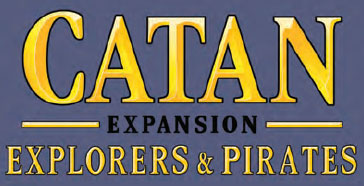
Required Game Components
You need the following game components from a copy of Catan (hereafter referred to as "base Catan"):
- All game components from the bag containing the "PIECES FROM BASE CATAN" sorting tile
- 6 frame pieces
- All roads and settlements
- 2 dice
- All resource cards (but no development cards)
You need the following game components from this Explorers &Pirates expansion:
- Frame pieces: 1x A1, A2, C1, C2, D1, F1, F2, and 2x B3
- The game pieces listed under "Preparation" on page 2
- The terrain hexes from the "Standard Hexes + Number Tokens Green and Orange" bag
- All of the gold coins
Setup
Before play, you must build the game board. First, you assemble the frame. Next, you create the starting island and the unexplored areas.
Assembling the Game Board Frame
Use the frame pieces from the base Catan game plus the frame pieces from Explorers &Pirates. Use the example as your assembly guide. The unmarked frame pieces in the example are from the base Catan game. Place the base Catan frame pieces face down.
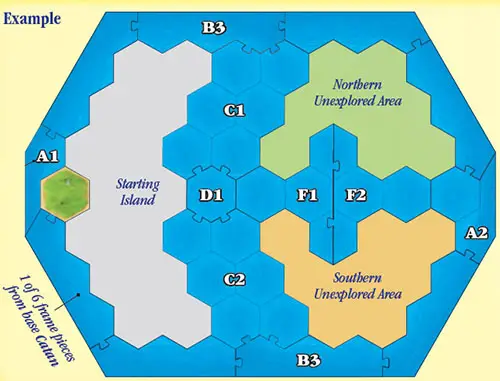
The completed frame divides the game board into 3 areas. The area to the west (with the pasture hex) is the starting island. Across the seas to the east are two unexplored areas.
These areas are separated by sea hexes formed by the F1 and F2 frame pieces. They are known as the northern unexplored area and the southern unexplored area.
Creating the Starting Island
Using the terrain hexes from the base Catan game, set up the terrain hexes on the starting island exactly as shown in example below. Once the hexes are done, place the number tokens from the base Catan game (again, exactly as shown).
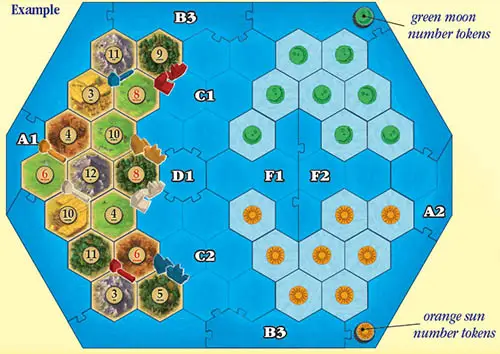
Building the Unexplored Areas
Before you place the hexes into the unexplored areas, sort them into two separate stacks according to the icon on their backs (green moons and orange suns). Shuffle each stack.
Using the 2nd example as a guide, place the hexes' icon side face up. The green moons go into the northern area. The orange suns go into the southern area.
Separate and shuffle the green moon and orange sun number tokens into two stacks. Place the stacks (icon side up) on the frame near the matching region.
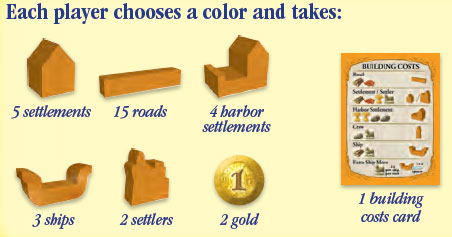
Preparation
Each player chooses a color and takes the following game pieces (see 2nd example above):
- 5 settlements from the base Catan game
- 15 roads from the base Catan game
- 4 harbor settlements from Explorers &Pirates
- 3 ships from Explorers &Pirates
- 2 settlers from Explorers &Pirates
- 2 gold from Explorers &Pirates
- 1 Explorers &Pirates building costs card
Place your pieces in front of yourself. The remaining wooden game pieces from Explorers &Pirates are not used in this introductory scenario.
Place the resource cards and dice from the base Catan game beside the game board to form a supply area.
Place the remaining gold coins in the supply area as well.
Set-up Phase
In this scenario, the starting positions are predetermined. Each player places 1 harbor settlement and 1 settler ship (a ship with a settler in the hold), as well as 1 settlement and 1 road, at the locations shown in example 2. In a 3-player game, don't place the game pieces of the fourth, unused color.
Starting resources: For each terrain hex adjacent to his or her settlement, each player takes the corresponding resource cards.
Special Rules for Two Players
Each player chooses a color. The game pieces of the nonchosen colors remain as obstacles on the starting island. Remove only the settler ships of the non-chosen colors.
Base Game Rules
The rules of the base Catan game also apply to all scenarios of this expansion, with the following exceptions:
There are no development cards.
There are no "Longest Road" and "Largest Army" special victory point cards.
Settlements cannot be upgraded to cities.
There is no robber piece to block resource hexes.
However, whenever a "7" is rolled, each player who has more than 7 resources still loses half of his or her resources. Starting with scenario 2, a pirate ship rule is added. It performs many of the same functions as the described in the classic robber rules.
The Phases of a Turn
I. Production Phase
On your turn, you roll for production as usual; the result applies to all players.
Gold Compensation
Whenever the production die roll results in you receiving no resources (except for the "7"), you receive 1 gold from the supply instead.
II. Trade and Build Phase
After the production phase, you may trade and build in any order you wish. For example, you may first build, then trade, then build again, etc.
3:1 Trade
In Explorers &Pirates, there are no harbors like the ones in base Catan. However, on your turn, you may trade resources at a 3:1 rate, i.e., return 3 resources of the same type to the supply and take any 1 different resource of your choice from the supply. You may also obtain 1 gold by paying 3 resources of the same type.
Paying Gold to Buy Resources (2:1)
Twice during your turn, you may pay 2 gold for any 1 resource of your choice from the supply. You may also trade gold with your opponents, just like resource cards.
III. Movement Phase
After you have concluded your trade and build phase, your turn's movement phase begins. During this phase:
You may move all your ships and perform actions with them.
You are not allowed to trade or build during or after the movement phase, except when you are "Building a Settlement with the Aid of a Settler Ship".
Your turn ends after the movement phase.
Sea Routes
Ships are moved along sea routes. The edges of a sea hex are called sea routes. Sea routes separate sea hexes from each other and terrain hexes from sea hexes. The edges of frame pieces bordering sea hexes or terrain hexes are also considered as sea routes.
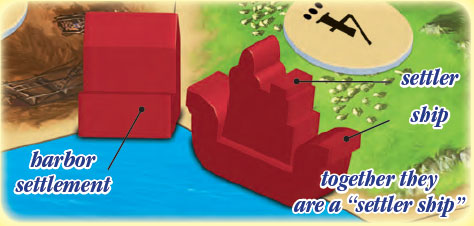
Ships
Ships transport various game pieces from one place to another in the ship's hold. A hold can only accommodate 1 large game piece (settler, fish haul) or 2 small game pieces (crews, spice sacks).
Building Ships
A ship costs 1 lumber and 1 wool to build. When you build a ship, place it on a sea route directly adjacent to one of your harbor settlements, with the following conditions:
You cannot place a ship on a sea route adjacent to an undiscovered hex, because building the ship there would immediately result in the discovery of this hex.
If you want to build a new ship when all your ships are already on the game board, you may remove any 1 of your ships from the game board and build the new ship adjacent to one of your harbor settlements for the usual ship building costs (1 lumber + 1 wool). Any pieces in the hold of a ship you remove are lost (return them to your supply).
Moving Ships
You may only move your ships during your movement phase.
Each of your ships has 4 movement points. Moving a ship from a sea route to an adjacent sea route costs 1 movement point.
You may move a ship in any direction and also change directions during its movement (e.g., you may move it forward and then back to the same space if you wish).
You must complete the movement of one ship before you can move your next ship.
During your turn, you may buy 2 additional movement points for a ship by spending 1 wool card. This may be done once (and only once) for each ship, each turn.
Up to 2 ships may occupy a given sea route. These ships may belong to the same or different players.
You may move your ship past another ship (or past 2 side by side ships). However, the movement of your ship may not end on a sea route that is already occupied by 2 ships.
Loading and Unloading Ships
Each ship has a hold that accommodates 2 small game pieces (crews or spice sacks) or one large game piece (settler, fish haul). Please note that the crews, spice sacks, and fish hauls are not used in this scenario. You may remove game pieces from a ship and return them to the appropriate supply. This could make sense if you want to make room for a more valuable game piece.
Loading and unloading a ship costs no movement points.
You may continue to move a ship after loading or unloading, provided that it still has movement points.
Discovering with Ships
To discover new land, you must move one of your ships towards the unexplored areas of the board (example A).
If, after moving a ship, one of its ends (bow or stern) points toward the corner (intersection) of an undiscovered hex, you must discover that hex (example B).
Turn the hex over. If it is a terrain hex, take a number token from the stack whose color/icon matches the color/icon on the back of the terrain hex and place it, number side face up, on the hex (example C).
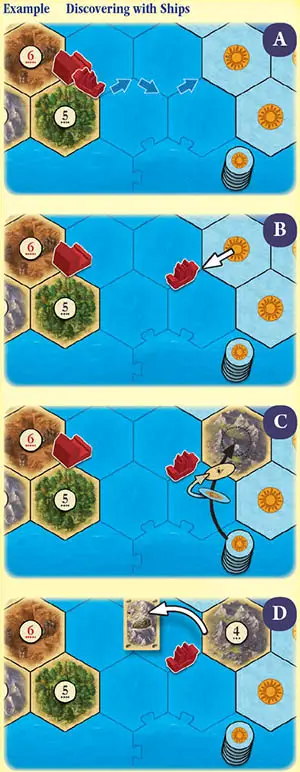
Reward for a Discovery
If you discover a terrain hex, as a reward you get 1 resource of the type produced by that hex (example D). If you discover any other type of hex (land or sea), you get 2 gold.
Discovery Ends a Ship's Movement
After a discovery, you are not allowed to move the ship any farther. Any remaining movement points are forfeited.
Harbor Settlements
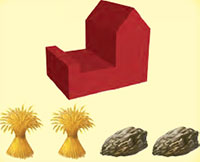
For 2 grain and 2 ore, you can upgrade any one of your coastal settlements (it borders a sea hex or the frame) to build a harbor settlement. Pay the building costs, return the settlement to your supply, and replace it with a harbor settlement.
A harbor settlement is worth 2 victory points.
A harbor settlement has a basin that can hold various game pieces. A basin can accommodate 1 large piece (settler, fish haul) or 2 small pieces (crews, spice sacks).
Important: When the number of an adjacent terrain hex is rolled, you receive only 1 resource for a harbor settlement. They do not produce 2 resources like cities in base Catan.
Settlements and Settlers
You can build settlements in 2 ways: either along a road, just like in base Catan; OR, by landing a settler ship (see below). You observe the distance rule in both cases.
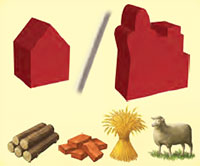
Building a Settler
Building a settler costs the same resources as building a settlement.
When you build a settler, you must place it either into the empty basin of one of your harbor settlements or directly into the empty hold of one of your ships. This ship must be located on a sea route adjacent to one of your harbor settlements. You are never allowed to place a newly built settler on land.
A ship with a settler in its hold is called a settler ship.
If the spaces in the harbor basin and in an adjacent ship's hold are occupied by another game piece, you can build the settler only if you remove the other game piece from the basin or hold and return it to your supply.
You are not allowed to move a settler overland. Your settlers can only be transported by your ships.
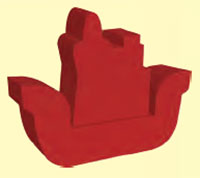
Movement Phase: Loading a Settler
If either end of your empty ship points toward one of your harbor settlements with a settler, you may load the settler onto the ship. You can move your settler ship just like a regular ship.
Important: Loading a settler onto a ship does not end the movement of the ship.
Building a Settlement with the Aid of a Settler Ship
If either end of one of your settler ships points toward the corner of a terrain hex (example A), you may build a settlement there (certain exceptions apply, which are explained in the context of the corresponding missions).
To build this new settlement, return both your ship and the settler in its hold to your supply (example B).
Place your new settlement on the intersection of the terrain hex, at no additional cost (example C).
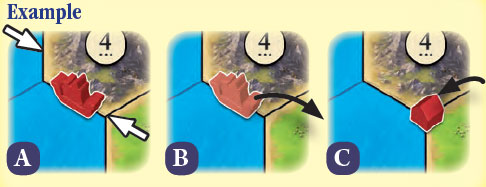
Important: When you build a settlement with the aid of a settler ship, you must always observe the usual Catan distance rule (2 paths between settlements).
In each of the two unexplored areas on the game board, you can only build your first settlement by using a settler ship. Once you have established your first settlement in this area, you can build roads and settlements there in a regular fashion. However, you could also forgo road building and build further settlements with the aid of settler ships.
Note: Roads may not be built on paths adjacent to undiscovered hexes, and settlements may not be built on intersections adjacent to undiscovered hexes. If you build a road in such a way that one of its ends points toward an undiscovered hex, you can't discover that hex. You can only discover hexes by means of ships.
End of the Game
You win "Land Ho!" if you reach 8 victory points (VP) on your turn.
Continue Reading


